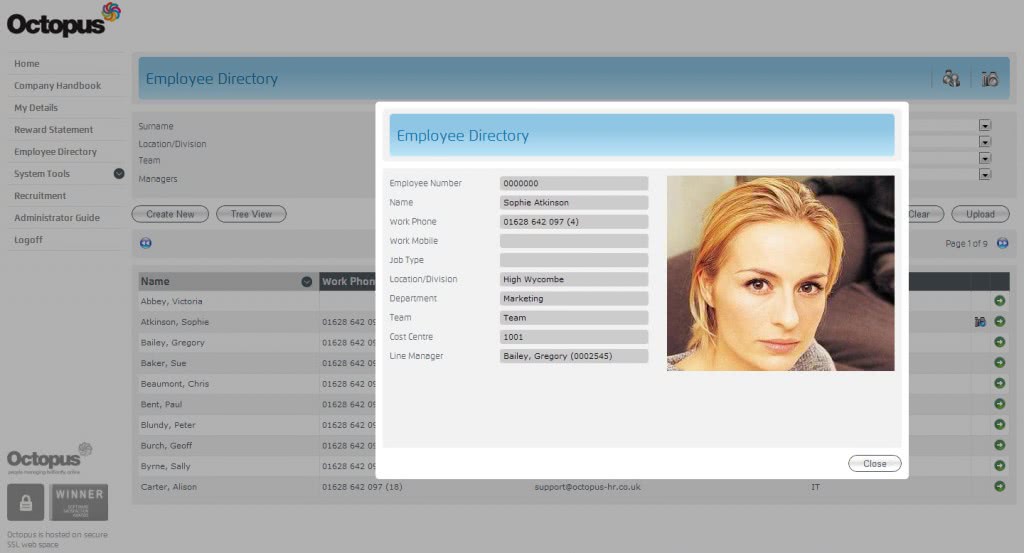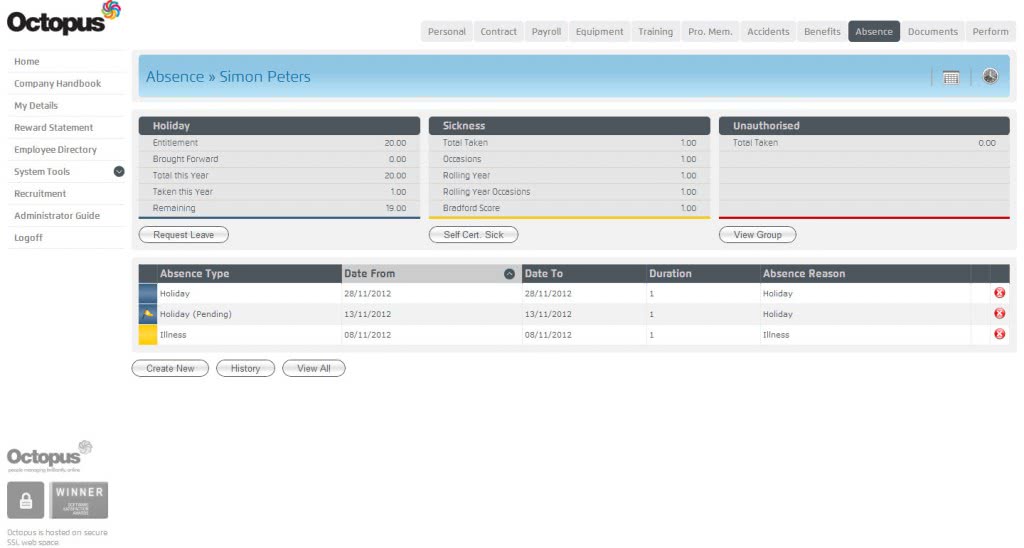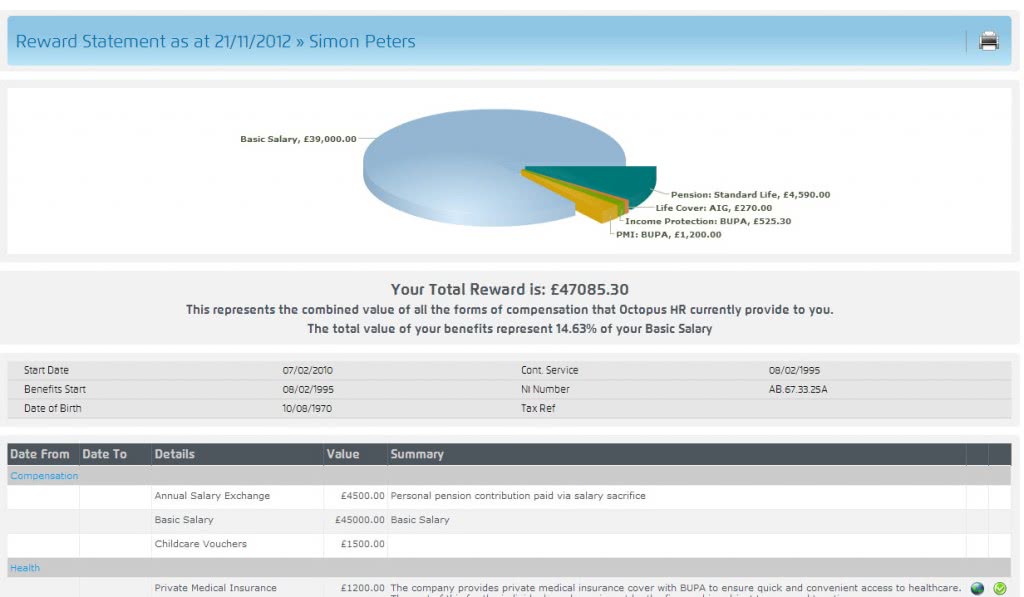Human Resources
Let's Talk Octopus HR: Behind the Software with Director Paul Beaumont

Does your organization have a self-service system employees can use to check up on the status of all their employee benefits and policies? If the system exists, is it intuitive enough to use that people actually use it? UK-based Octopus HR, a privately owned, domestically focused vendor in a segment filled with big-name acquisitions, has crafted a SaaS HR solution geared towards smaller businesses and enterprises that addresses intuitiveness gap.
In this interview with Director Paul Beaumont we learned how Octopus HR uses client feedback and preemption of latent trends to guide the ongoing growth of its product.
Was there a specific HR issue that you set out to address when Octopus got started?
Back in February 2004 we had a previous business as an employee benefits consultancy. We weren’t even operating in the HR space. We were effectively providing employee benefits to companies, pension schemes, life insurance, medical insurance, those types of things. We would provide the set up and financial advice companies needed to establish those schemes and deliver them to their employees, and what we were finding was that we wanted to differentiate ourselves from the other companies in that space. We felt the need to throw a little bit of technology at the problem.
What we did is we embarked on a little development project were we sought to provide what we called the total reward statements to the employees of our corporate clients. We built a secure website which effectively allowed employees to log in and view which benefits they were enrolled in and the value of those benefits to them as an individual.
The project served its purpose. It differentiated us from our competition and added value to the services we were providing to our clients. More of our clients and more of their employees were using that very small piece of software. They were asking for more pieces of company information to be added to it–it would be great if we could record information about children and dependents for example, and it would also be great if we could record home addresses and emergency contact details. So what happened is that we were being asked to add more and more HR functionality into the product at a very, very basic level. From there we got more and more involved in mainstream software development.
That dovetails into my next question: how would you characterize your approach to the development of HR management software?
Our approach is a highly collaborative one. We are highly engaged with our user community and we encourage them to submit their feedback and product suggestions to us. So in general when do product releases, which is roughly around four times a year, I would say 80 percent of more of the features that go into a release are stuff that we took directly from our clients.
We’re in a permanent state of innovation, and a lot of those ideas are coming from our user community. Fundamentally, our approach is to build solutions that are fit to purpose and what our clients want them to do, not our perception of what we think clients want. We are being told “this is what we need,” so we go and build it.
Are there any special considerations that have to be taken into account when dealing with the sort of small-to-medium enterprise (SME) clientele you target that wouldn’t exist for a large-scale multinational or a smaller company?
Well, typically in the SME space the functional requirements are less sophisticated than they are in, say, blue chip organizations. In that sort of ERP space the bigger businesses have a lot of history behind them. They have a lot of baggage that comes along with them as they go through acquisitions. They have got issues about harmonizing compensation benefits across different communities and employees, and, because of their scale, their internal structure is much more complicated. There’s a very different approach to scaling for 40, 50, 100,000-employee businesses versus businesses that have 300-500 employees, which affects the way you approach some of the functionality requirements.
You can’t show someone 30,000 employee records in one hit, so you have to come with ways for how those businesses are going to interact with the solution. User interface in particular is very different when you’re looking at slightly smaller businesses. Bigger businesses are often much more into competency framework and succession planning and all those types of things. User interface in particular is very different when you are looking at slightly smaller businesses.
One of the main reasons we don’t target the larger organizations is because in the UK that market is completely saturated. When we started our HR software business we decided to target a specifically different market. That market would be a new opportunity rather than going into a crowded or replacement marketplace, which is a lot harder to gain traction in. We decided this is the market we’re going for, this is the architecture, this is the delivery model. The targeted aspect enabled us to identify the relevant functionality and level of complexity for that market, and we architected the product within those parameters.
The majority of your clients either UK based or headquartered. Is breaking into the North American market and others a priority for you, or are you mostly concerned on consolidating the niche you’ve established domestically?
It’s an open agenda item at some board meetings. The simple answer is yes, we concentrate on our home market, there’s simply an enormous opportunity for us within our own geography. That’s the first thing.
We do talk about entering other geographies, but I think you’ve got to be very cautious when trying to move into other markets, particularly other geographies, because in my days at Microsoft I’ve seen it first-hand. You need to have very deep pockets to be able to do it effectively. It is fundamentally a very costly and time-consuming exercise. Again, it can depend on the size of your business; it can also take your focus off your own core activities. So if we were going to do anything like that we would do it through a partner, we wouldn’t look to establish ourselves as a, if you like, independent business in another geography.
From a software standpoint there are some issues that aren’t issues, but certainly significant like language issues and localization–for example, you guys have Social Security numbers, whereas we have national insurance numbers. There are little things like that that need to be dealt with. There are also a potential degree of legislative requirements when you go to another geography, also support times and access to support. In certain geographies there are issues about data protection and data moving across borders. All of that ties back to what I said earlier, that if we were looking to establish ourselves in another geography there would obviously be a fairly significant search to make sure that we are working with the right people on the ground locally.
IBM, Oracle and SAP have all created footprints in the HR software market via a series of acquisitions last year. What’s your view on consolidation in the HR space?
It’s interesting. Certainly in the UK there has been consolidation in the HR space going on for the last ten years. It’s often being driven by vendors who perhaps haven’t kept pace with the technological trends. So perhaps rather than “acquisition” I often use the term merger, which is often about survival or adding some value to the acquirer.
Obviously IBM, SAP and Oracle are making strategic acquisitions, and at the same time they’re buying market share. Often this can be the case–and I am sure none of them would admit it, but oftentimes they are just defensive maneuvers to keep a significant footprint in emerging sectors. There are a lot of things that can be feeding into those decisions to buy. It often means that we actually see an increase in business for a number of reasons. After a major acquisition there can be a period of inertia that settles in where the acquired organization merges itself into the acquiring company. That can often present a little bit of a hiatus for that vendor and that gives us an opportunity. It also can, and often does, unsettle the existing clients because they are not quite sure what the future holds for their relationship with that particular vendor. I can think of several examples over where we have seen some vendors get acquired and almost completely disappear from the company landscape. So by and large I would say the consolidation we have seen over here in our space has often been a benefit to us, and we’ve seen an upturn in business just because we’re perceived as still being independent.
Where do you see the HR segment going in the near future?
In the near future I think if you are not delivering a self-service or full service application, you are going to be in trouble. You need to be able to have your solution deployed across the whole organization. I think that’s key.
It’s interesting to note that for businesses that are employing people the fundamentals of managing the on-boarding of a new employee, their life cycle with you at your organization and the way they exit the business–those elements haven’t changed very much. I don’t think they are going to change very much. I think the way businesses interact with their employee community is where the biggest change is going to come from.
The whole social media interface is, I think, going to be quite important in the HR domain over the next few years given the age of the workforce and the accelerated rate at which new technologies are adopted. I think about my own children and my directors’ children, their intuitive acceptance of social media applications, Facebook, Twitter that model of interaction with software is going to be quite interesting in terms of how it’s going to be used in the HR space. Again, it creates a user environment a lot of people are very familiar with because they’re already using similar interfaces outside of the workplace in a social context.
How do you view the impact of the consumerization of IT on HR software specifically?
There’s a particularly strong place for it in the HR domain because at the end of the day your employee community is, to an extent, a social entity. That means you’re collaborating with employees in a different way in terms of subject matter and content versus on personal platforms, but the fundamentals remain the same in that you are still collaborating with people you know and sharing information with them. It just happens that that information in the business context.
So that’s something we obviously have more than one eye on as a development opportunity. Whether or not it’s something we develop specifically for ourselves in terms of building our own technology, or if we use existing platforms that are out there, I don’t know yet. We need to do a bit more research on that, but it’s certainly something I am very keen on for us as a business to explore, because I think there’s a lot of opportunity and that’s where I see this segment headed.
We don’t want to be swimming upstream. We want to start going where we think people are going to be taking us because that’s one of the challenges of running any sort of technology software whether it’s software, hardware or anything else. You need to go and stay ahead of the curve.
Learn more about Human Resources software by downloading our free Top 10 Human Capital Management Software report, or browse top human resources and other human capital management solutions on our Human Resources research center page.









